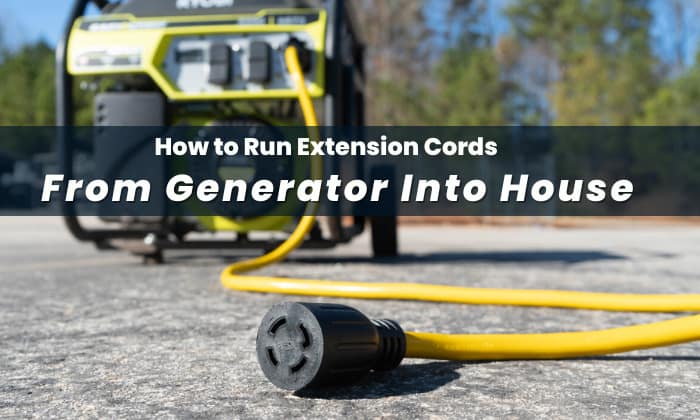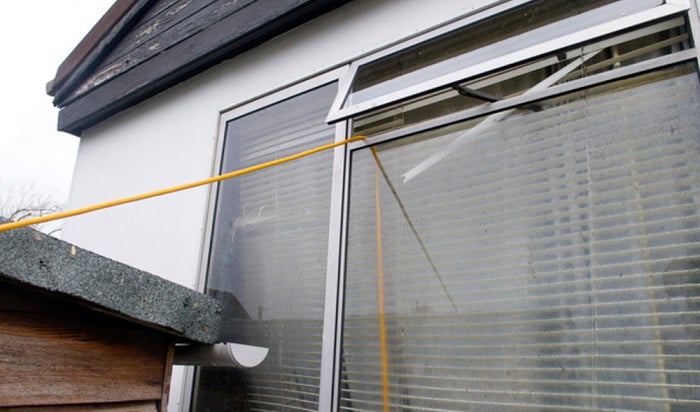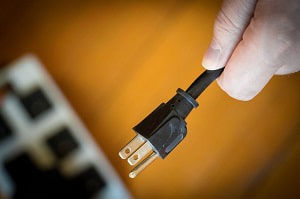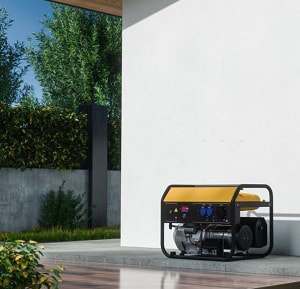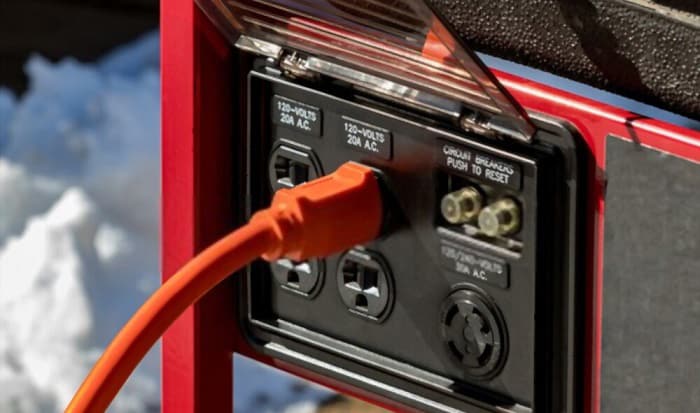There just comes a time in one’s life when learning how to run extension cords from generator into house is a must.
Once you get a good grasp of the best technique, you’ll never look back – well, at least, to the time(s) when you had massive doubts about whether to drill a hole through your property’s wall and the setup’s overall safety.
This guide outlines how to properly hook up a portable generator to a house in two methods. Both are free of the usual electrical risks and reduce generator noise as much as possible.
A Couple of Extension Cord Tips:
- Refrain from using an extension cord that’s too long. Aim to get the length that’s exactly right for your intended run.
- Twist lock plugs heighten safety against moisture issues.
- Buy the right cord that splits into the correct number of outlets you intend to use.
Table of Contents
Cheap But Effective Way to Run Generator Extension Cords into House
These are all you’ll need
- Generator appropriate for your intended loads
- Three-prong or four-prong, grounded outlet generator extension cord with the right gauge
- 2×2 sticks
Once you’ve got the above items, follow these steps:
Step-by-Step Guide
1. Read the generator’s manual to confirm your requirements and needs, then ground your generator.
This includes pinpointing the size of wire you need to use and, equally important, confirming whether you need to ground the generator or not. Most likely, this is necessary, especially as you’re using a portable generator with extension cords to power your tools and appliances.
- To ground the device, you can either contact an electrician to do it for you or use a jumper cable or long enough wires to ground it to a metal pipe or fence post.
- It’s important for the generator to stay outdoors but not be subjected to rain (i.e. become in any way wet) when running. Remember: Carbon monoxide emissions can lead to death! Keep the generator’s exhaust pointed away from your home as much as possible.
Related:
- Things to Do When Your Extension Cord Gets Wet
- The Most Effective Methods to Protect Outdoor Extension Cords from Rain
2. Decide how you’re going to run the extension cord into your home through the window.
Many people encounter this stumbling block. How are you going to put the cords from outside to inside without (accidentally) inviting the local burglar into your property?
If you’ve been considering running the cable through the door, you need to remove that thought immediately, as you’ll be inviting injury to people on your property, especially if they tend not to look at the ground when walking.
In most cases, the ideal setup for a generator to house cord is through the window. There are two ways I normally do this. One is less secure but more budget-friendly than the other.
While I did say it’s “less secure”, I didn’t necessarily mean it leaves your property completely exposed. It goes like this:
You’ll only be opening the window just enough to let the cord in. To “lock” the window in place, you can prop and secure medium-sized sticks (2×2 will do) against either side of the window. You have to keep the sticks secure!
A little janky, I know (especially if you have mosquitoes!) But, hey, it has worked for me like a charm whenever I needed to run a generator cable to the house.
If you want a more secure setup, then read the next steps.
Run Extension Cords Using a Pool Noodle
I’ve been able to power a house with a generator using a pool noodle setup. What makes it great is that it leaves no openings whatsoever, so bugs (and intruders) can just bugger off.
For this method, you’ll need
- Pool noodle
- Tape measure
- Serrated knife
- Drill
Just follow these steps
- Choose a pool noodle that has a large enough diameter for better rigidity and enough room to fit bigger cables.
- Measure the window that you’ll be putting the pool noodle in using a tape measure. Note down the distance between the ends of the tracks’ interior.
- Cut the pool noodle based on your measurements. You have to cut it cleanly, so as to prevent air gaps. A sharp serrated knife will suffice for cutting.
Make an entry point and slit for the cord on the pool noodle, then place it on the window.
- Drill a hole through the pool noodle, big enough for the cord to enter – the snugger, the better. I’ll leave the position where you’ll be punching the hole up to you, since every setup is different.
- Cut a slit from the top portion of where you drilled the hole up to the bottom of the hole. This way, it will be easier to insert the extension cord into the pool noodle.
- Cut two other slits on the pool noodle’s ends, perpendicular to the hole slit you made. The point of these slits is for the pool noodle to grasp either side of the window’s tracks.
- Place the pool noodle on your window, making sure the slits on either side will grab and have a secure hold on the tracks.
- Insert your 30 amp generator extension cord into the slit you made, then close the window. You’re practically done at this point.
- You can choose to use the sticks I suggested earlier and then prop them on the gap between the window and window frame from the inside. You may have to measure the exact distance and cut the right-sized stick or board to do this correctly, though.
- Never overlook hazards when running extension cords from the generator. Make sure the extension cord’s run will not be covered by anything that may cause the cable and wires to overheat.
FAQs
How far can you run an extension cord from a generator?
Always consider distance when attempting to plug a generator into a house to avoid issues like overheating of wires and overloading.
If, for example, you’re trying to run the generator’s cord to the refrigerator, you have to account for the minimum distance between your fridge and the generator. This distance should be at least 20 feet.
Be mindful of noise. For this, I suggest you position your generator a little farther away from your home as much as possible and place it in a baffle box or other generator enclosures. The box being waterproof will add a nice bonus touch.
What extension cord do I need for a generator?
Buy one that’s designed specifically for generator use. Never use regular extension cords with a generator, particularly one that’s rated for indoor use.
Also, don’t connect numerous power strips together, as most extension cords for this purpose already come with multiple outlets.
How do you hook up a generator to a house without a transfer switch?
Feel free to follow the methods I outlined here, the pool noodle method specifically. You can also opt for a procedure that involves setting up an outlet utility box, drilling a hole through which you’ll be running the cord, and installing a waterproof box to house it.
Conclusion
Despite the common reservations experts have about this topic, you shouldn’t completely cross out your musings of, “Should I connect a generator to my house using extensions?” and other related questions. Many folks do it.
You can’t forgo knowing the exact steps and options on how to run extension cords from generator into house, though. Again, before you start, pay attention to your setup and requirements, anticipate possible issues that may arise, then follow any of the methods I shared here.

I am Edwin Jones, in charge of designing content for Galvinpower. I aspire to use my experiences in marketing to create reliable and necessary information to help our readers. It has been fun to work with Andrew and apply his incredible knowledge to our content.

